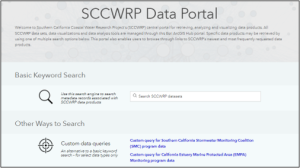New SCCWRP data portal enhances access to most-requested data products

SCCWRP has publicly unveiled a web-based data portal that provides centralized access to millions of environmental data points and cutting-edge data analysis tools – the culmination of a years-long effort to create a one-stop shop for easily retrieving, visualizing and analyzing SCCWRP’s most requested data products.
The data portal, which went live in November, is built on the Esri ArcGIS Open Data platform and features flagship regional monitoring data sets from the Southern California Bight Regional Monitoring Program, Southern California Stormwater Monitoring Coalition (SMC), and California Estuary Marine Protected Area (EMPA) Monitoring Program, among many other data sets dating back decades.
Many of these programs and projects have been building out a data presence on the Open Data platform for years; the centralized data portal is designed to consolidate and streamline all of these data initiatives under one roof, while simultaneously enhancing and polishing the user experience.
Many of the features and functionalities built into SCCWRP’s central data portal were developed in response to extensive testing and feedback from SCCWRP’s member agencies and other partners.
The open data portal, which is linked from the main SCCWRP website, solves many of the historical challenges that SCCWRP staff and public end users have faced storing, retrieving and analyzing environmental data sets.
With SCCWRP’s previous data web page, for example, users who wanted to access data sets were required to download individually separated raw data files for each of their data queries and then manually compile them into a single file – a complicated and labor-intensive process prone to errors for inexperienced users.
The new data portal enables users to easily retrieve data using a search engine or interactive ArcGIS map interface. Users can simply filter data products with keywords or guided queries for different subsets of data, such as specific locations, time periods, or measurement parameters (i.e., individual pollutants or biological species), in addition to entire data sets. Selected data can then be downloaded in different formats as defined by the user.
Another feature of the new data portal is improved data uploading. Previously, when users submitted their data to SCCWRP, someone would need to laboriously complete quality-assurance steps by manually validating the completeness, accuracy and precision of uploaded data.
Automated quality-assurance checkers now review all data submitted to SCCWRP and flag or reject data that don’t meet specific quality-assurance criteria. The checkers ensure all submitted data are of the highest quality and enable data submitters to efficiently repair data sets before submission, saving hundreds of hours and paving the way for data submissions in minutes instead of months.
All new SCCWRP data products going forward will be accessible through the data portal. SCCWRP has developed internal staff guidelines to ensure all data products are ready for public dissemination and maintained to consistently high standards over time.
Many of SCCWRP’s key historical data sets dating back to the 1970s already have been migrated to the data portal; others are still in the process of being transferred, including data housed in SCCWRP’s 1990s-era predecessor data portal.
SCCWRP is continuing to enhance the data portal with new online data analysis and visualization capabilities, including tools for creating maps and seamless integration of web-enabled assessment tool calculators. These features enable anyone with an internet connection the ability to use leading-edge research tools.
For more information, or to be added to SCCWRP’s list of candidate beta-testers, contact Paul Smith.
More news related to: Regional Monitoring, Top News